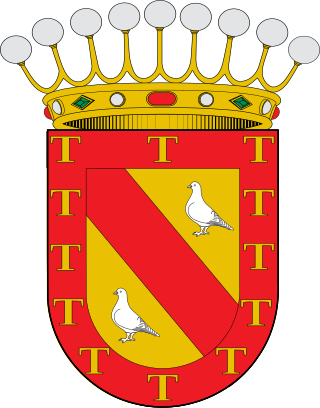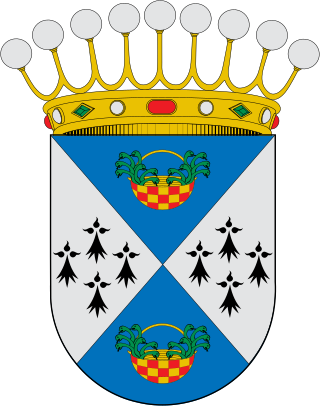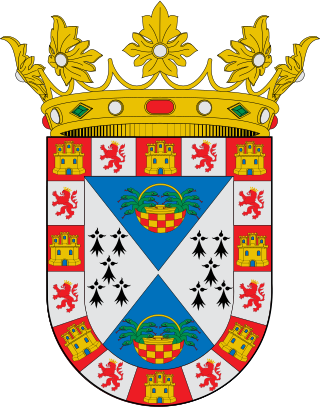
The Spanish nobility are people who possess a title of nobility confirmed by the Spanish Ministry of the Presidency, Justice and Relations with the Cortes, as well as those individuals appointed to one of Spain's three highest orders of knighthood: the Order of the Golden Fleece, the Order of Charles III and the Order of Isabella the Catholic. Some members of the Spanish nobility possess various titles that may be inherited or not, but the creation and recognition of titles is legally the prerogative of the monarchy of Spain.

Beltrán Alfonso Osorio y Díez de Rivera, 18th Duke of Alburquerque, GE, OSL, also known as the 'Iron Duke' of Alburquerque, was a Spanish peer and jockey. A profound monarchist, he was a close friend and confidant of the heir to the throne of Spain, the Count of Barcelona, who he served as the Head of his Household from 1954 to 1993.
The Sicilian title Duke of Bivona stems from the middle 16th century. Bivona is in Sicily, which had been conquered by Peter III of Aragon in 1282. It was given to people related to the powerful medieval Aragonese family of Luna, Zaragoza.

Marquess of Estepa is a Spanish hereditary title accompanied by the dignity of Grandee and created by King Philip II by decree on 28 May 1543 and by letters patent on 20 April 1564 in favour of Marco Centurión. The title refers to the area of Andalusia of Estepa, in the province of Sevilla and its jurisdiction included the places Estepa, Alameda, Aguadulce, Badolatosa, Casariche, Gilena, Herrera, La Roda, Lora, Marinaleda–Matarredonda, Miragenil, Pedrera and Sierra de Yeguas.
The Caballerizo mayor was the Officer of the Royal Household and Heritage of the Crown of Spain in charge of the trips, the mews, and the hunt of the King of Spain.
The Mayordomo mayor was the Officer of the Royal Household and Heritage of the Crown of Spain in charge of the person and rooms of the King of Spain. The Office of “Mayordomo mayor” was suppressed after the proclamation of the Second Spanish Republic in 1931 and never re-created after the restoration of the Monarchy in 1975, but it can be said that it is the historical precedent of the modern Head of the Royal Household of Spain.

Coloma or de Coloma or Colomba is an old important Spanish Noble House. A branch belongs to the Flemish nobility, and became the Counts of Bornhem. Other branches became the Counts of Elda, Marquesses of Espinar, Marquesses of Noguera and Marquesses of Canales de Chozas.

Count of Teba is a hereditary title in the Peerage of Spain, granted in 1522 by Charles I to Diego Ramírez de Guzmán, son of the 1st Lord of Teba. The name makes reference to the municipality of Teba, in Málaga, Spain.

Duke of Fernán Núñez is a hereditary title of nobility in the Peerage of Spain accompanied by the dignity of Grandee. The Countship of Fernán Núñez granted in 1639 to Alonso Gutiérrez de los Ríos was elevated to a dukedom in 1817 in the person of Carlos Gutiérrez de los Ríos, who became the 1st Duke of Fernán Núñez. The accompanying Grandeeship was granted in 1728, prior to being elevated to a Dukedom.

Count of Bornos is a hereditary title in the Peerage of Spain accompanied by the dignity of Grandee, granted in 1642 by Philip IV to Diego Ramírez de Haro, captain of arquebusiers and Gentilhombre of Charles II when he was an infant.

Marquess of Castel-Moncayo is a hereditary title in the Peerage of Spain, accompanied by the dignity of Grandee. It was granted in 1682 by Charles II to Baltasar de Fuenmayor, ambassador in Denmark–Norway, the Spanish Netherlands and the Republic of Venice.

Duke of Montellano is a hereditary title in the Peerage of Spain, accompanied by the dignity of Grandee and granted in 1705 by Philip V to José de Solís, Count of Montellano, Adelantado of Yucatán and descendant of Francisco de Montejo. It makes reference to the town of Montellano in Seville.

Count of Baños is an hereditary title in the Peerage of Spain accompanied by the dignity of Grandee, granted in 1621 by Philip IV to Sancho Martínez de Leyva, iure uxoris Marquess of Leyva and knight of the Order of Santiago.

Count of Salvatierra is a hereditary title in the Peerage of Spain, accompanied by the dignity of Grandee and granted in 1613 by Philip III to Diego Sarmiento de Sotomayor, Lord of Salvaterra and of the Castle of Sobroso.

Count of Altamira is a hereditary title in the Peerage of Spain, accompanied by the dignity of Grandee and granted in 1455 by Henry IV to Lope Sánchez de Ulloa, Lord of the Fortress of Altamira.

Marquess of Astorga is a hereditary title in the Peerage of Spain, accompanied by the dignity of Grandee and granted in 1465 by Henry IV to Álvar Pérez Osorio, 2nd Count of Trastámara and captain general of Galicia and Asturias.

Duke of Sanlúcar la Mayor is a hereditary title in the Peerage of Spain, accompanied by the dignity of Grandee and granted in 1625 by Philip IV to Gaspar de Guzmán, 3rd Count of Olivares and royal favourite to the king.

Duke of Baena is a hereditary title in the Peerage of Spain, accompanied by the dignity of Grandee and granted in 1566 by Philip II to Gonzalo Fernández de Córdoba II, who was the 7th Lord of Baena, 5th Count of Cabra and 3rd Duke of Sessa, Santángelo, Terranova, Andría and Montalto.

Duke of Soma is a hereditary title in the Peerage of Spain, accompanied by the dignity of Grandee and granted in 1502 by Ferdinand II to Ramón Folch de Cardona, 11th Baron of Bellpuig and 1st Count of Oliveto, for his services as viceroy of Sicily.
















